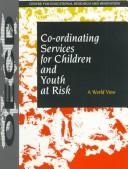| Listing 1 - 10 of 41 | << page >> |
Sort by
|
Periodical
Year: 2006 Publisher: [Paris] : LʹEcole nationale de protection judiciaire de la jeunesse
Abstract | Keywords | Export | Availability | Bookmark
 Loading...
Loading...Choose an application
- Reference Manager
- EndNote
- RefWorks (Direct export to RefWorks)
Book
ISBN: 303777763X 3037772166 Publisher: Seismo
Abstract | Keywords | Export | Availability | Bookmark
 Loading...
Loading...Choose an application
- Reference Manager
- EndNote
- RefWorks (Direct export to RefWorks)
Die aktuelle, vierte Auflage des Handbuches Offenen Kinder- und Jugendarbeit hat ein ganz neues Konzept bekommen und viele Inhalte wurden erstmalig aufgenommen. Das Handbuch ist seit vielen Jahren das Schlüsselwerk zu dem großen Arbeitsfeld der Offenen Kinder- und Jugendarbeit. Das Handbuch schließt relevantes Wissen auf und regt Reflexion an. Es unterstützt Fachkräfte der Praxis bei der Klärung ihres Selbstverständnisses, ihrer Ziele und Arbeitsweisen. Das Handbuch hilft pädagogisches Handeln im komplexen Feld der Offenen Kinder- und Jugendarbeit professionell zu gestalten, es nach außen zu b.
At-risk youth --- Behavior modification. --- Problem youth --- Behavior modification
Periodical
ISSN: 27669300
Abstract | Keywords | Export | Availability | Bookmark
 Loading...
Loading...Choose an application
- Reference Manager
- EndNote
- RefWorks (Direct export to RefWorks)
Problem youth --- Problem youth. --- Youth --- At-risk youth (Social sciences) --- Maladjusted youth --- Troubled youth --- Youth at risk (Social sciences) --- Youth with behavior disorders --- At-risk youth --- At-risk youth.

ISSN: 1373024X ISBN: 2804152391 9782804152390 Year: 2006 Volume: *1 Publisher: Bruxelles : De Boeck,
Abstract | Keywords | Export | Availability | Bookmark
 Loading...
Loading...Choose an application
- Reference Manager
- EndNote
- RefWorks (Direct export to RefWorks)
Adolescents --- Jeunes en difficulté --- Problem youth --- Adolescent psychopathology --- Psychopathologie --- At-risk youth. --- Jeunes en difficulté
Book
ISBN: 9781566894173 Year: 2016 Publisher: Minneapolis : Coffee House Press,
Abstract | Keywords | Export | Availability | Bookmark
 Loading...
Loading...Choose an application
- Reference Manager
- EndNote
- RefWorks (Direct export to RefWorks)
Teenage boys --- At-risk youth --- Latter Day Saint churches --- Blood accusation --- Latter Day Saints --- Murder --- History
Periodical
Year: 1993 Publisher: Bloomington, IN : National Educational Service,
Abstract | Keywords | Export | Availability | Bookmark
 Loading...
Loading...Choose an application
- Reference Manager
- EndNote
- RefWorks (Direct export to RefWorks)
Problem children --- At-risk youth --- Social work with children --- Social work with youth --- Problem children. --- At-risk youth. --- Social work with children. --- Social work with youth. --- United States. --- United States
Book
ISBN: 9782370290199 Year: 2017 Publisher: Paris : AFRHC ,
Abstract | Keywords | Export | Availability | Bookmark
 Loading...
Loading...Choose an application
- Reference Manager
- EndNote
- RefWorks (Direct export to RefWorks)
"Ténèbres empoisonnées" ... L'expression employée dans les années 1950 pour désigner le loisir cinématographique et ses effets sur le jeune public dit bien la peur qui s'est emparée alors des spécialistes de l'enfance, qu'il s'agisse des éducateurs ou des professionnels de la justice des mineurs. En réalité, le cinéma, comme source de modernité, inquiète certains de ces spécialistes depuis longtemps, depuis son origine quasiment.Mais l'après Seconde Guerre mondiale va être marquée par une reviviscence particulièrement forte de ces peurs sociales anciennes car, au moment de la reconstruction, la jeunesse devient un sujet de préoccupation majeur, d'espoir mais aussi de crainte comme en témoignent les gros titres de la presse qui pointent sans cesse l'attention sur l'accroissement du phénomène de la délinquance juvénile. De là, il n'y a avait qu'un pas à franchir pour établir une corrélation entre l'expansion de cette forme de criminalité et le développement du cinéma, comme facteur d'influence direct ou secondaire.Toutes les caractéristiques du cinéma alimentent alors les inquiétudes. Le fait qu'il s'agisse d'un loisir qui se goûte dans la pénombre d'une salle, parfois située dans la périphérie des grandes villes ou aux abords de quartiers mal famés, que les jeunes aiment s'y rendre en bande ou pour flirter, que les films véhiculent des modes de vie bien éloignés des conditions réelles de la vie ordinaire avec leur lot de gangsters, de rebelles et de femmes légères, qu'ils agissent sur le psychisme selon des modalités que les psychologues ne parviennent pas à expliquer, provoquant chez tous, et plus encore chez les plus jeunes, un véritable "besoin" de cinéma.C'est au sein du secteur de l'Education surveillée que seront entreprises, dès 1947, les premières études dites scientifiques pour tenter de déterminer la part exacte du cinéma dans le phénomène général de la délinquance juvénile. Une grande enquête est alors lancée auprès des centres situés sur l'ensemble du territoire national, composée de deux versants, l'un sociologique et l'autre psychologique.Des ramifications se développent rapidement, au point que la question du cinéma devient une préoccupation centrale pour l'ensemble des spécialistes de la justice des mineurs. Ces travaux et ces discours constituent la matière centrale de cet ouvrage qui entend éclairer, grâce à une approche inédite, les composantes du débat sur le cinéma et la délinquance juvénile tel qu'il se posa, de la Libération aux années 1960.
Motion pictures and youth --- Motion pictures --- Juvenile delinquency --- Problem youth --- Social aspects --- History --- France --- Social conditions --- Cinéma --- Cinéma et jeunesse --- Jeunesse --- Aspect social --- Attitudes --- At-risk youth
Book
ISBN: 9789264267701 Year: 2016 Publisher: Paris : OECD,
Abstract | Keywords | Export | Availability | Bookmark
 Loading...
Loading...Choose an application
- Reference Manager
- EndNote
- RefWorks (Direct export to RefWorks)
This report is part of the series on "Investing in Youth" which builds on the expertise of the OECD on youth employment, social support and skills. This series covers both OECD countries and countries in the process of accession to the OECD, as well as some emerging economies. The report provides a detailed diagnosis of youth policies in the area of education, training, social and employment policies. Its main focus is on disadvantaged youth including those at risk of disengaging.
Youth --- At-risk youth --- Employment --- Education --- Sweden --- Maladjusted youth --- Problem youth --- Troubled youth --- Youth with behavior disorders --- Young people --- Young persons --- Youngsters --- Youths --- Age groups --- Life cycle, Human
Book
ISBN: 0197611540 0197611532 Year: 2022 Publisher: New York, New York : Oxford University Press,
Abstract | Keywords | Export | Availability | Bookmark
 Loading...
Loading...Choose an application
- Reference Manager
- EndNote
- RefWorks (Direct export to RefWorks)
In Willful Defiance, by Mark R. Warren tells the story of how Black and Brown parents and students organized to dismantle the school-to-prison pipeline in their local schools and built a movement that spread across the country. He examines organizing processes in Mississippi, Los Angeles, Chicago, and other localities, showing how parents and students of color changed exclusionary discipline policies that suspend and expel students of color at disproportionate rates and policing practices that lead students into the juvenile and criminal justice systems. The book documents the struggle to build a movement led by community groups rather than Washington-based professional advocates and offers a new model for federated movements that win policy changes to transform deep-seated and systemic racism in public schools and broader society.
Racism in education --- Discrimination in school discipline --- At-risk youth --- Youth with social disabilities --- Juvenile delinquency --- Discrimination in juvenile justice administration --- Educational change --- Education --- Education --- Prevention.

ISBN: 1280030224 9786610030224 9264163190 9264160388 Year: 1998 Publisher: Paris : OECD Publishing,
Abstract | Keywords | Export | Availability | Bookmark
 Loading...
Loading...Choose an application
- Reference Manager
- EndNote
- RefWorks (Direct export to RefWorks)
Some 15 to 30 per cent of our children and youth are at risk of failing in school where learning and behaviour problems touch ever younger children. In many countries with very different political and cultural backgrounds, these challenges are being met by increasing the co-ordination of education, health and social services, a process often galvanised by a broader involvement, extending to business and senior citizens. This is more than merely tinkering with statutory systems of service provision. Current services are mismatched; our vision of the family and its needs is changing along with the balance between prevention and remediation, and the ways that professionals work together. This book provides the detailed stories of how this process has developed in seven OECD countries: Australia, Canada, Finland, Germany, the Netherlands, Portugal, and the United States. It looks at system change from the points of view of policy-makers, managers, practitioners and service users. It provides information on the background to the changes, highlighting what was provided to help the changes happen and investigating the process of change and the outcomes of the reforms. The scope of the work is broad: it covers pre-school, school age and transition to work.
Social Issues/Migration/Health --- Education --- Problem children --- Problem youth --- Social Sciences --- Education, Special Topics --- Services for --- At-risk youth (Social sciences) --- Maladjusted youth --- Troubled youth --- Youth at risk (Social sciences) --- Difficult children --- Maladjusted children --- Youth --- Children --- Behavior disorders in children --- At-risk youth --- Youth with behavior disorders
| Listing 1 - 10 of 41 | << page >> |
Sort by
|

 Search
Search Feedback
Feedback About UniCat
About UniCat  Help
Help News
News